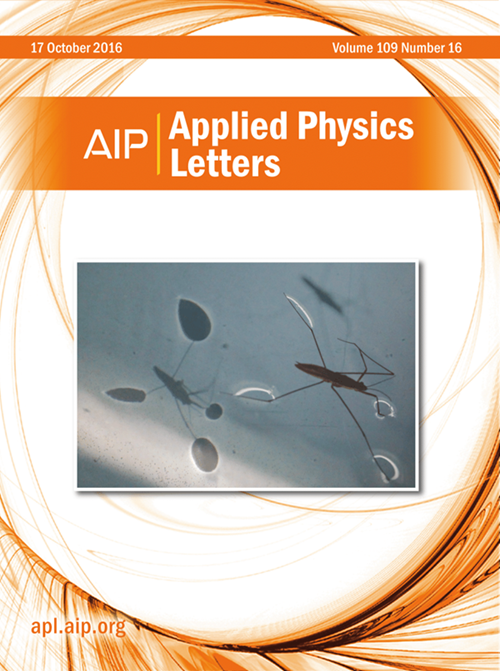氧等离子体预处理在MoS2上实现GeSn量子点的Van der Waals外延
IF 3.6
2区 物理与天体物理
Q2 PHYSICS, APPLIED
引用次数: 0
摘要
GeSn量子点(QDs)由于其直接带隙和与CMOS技术的完全兼容而成为单片光电集成的候选者,受到了广泛的关注。然而,由于Sn在Ge中的溶解度较低,以及低温下在Ge或Si衬底上生长的相干应变GeSn层过厚,因此制备GeSn量子点仍然是一个很大的挑战。本文利用磁控溅射技术,在SiO2/Si衬底上,在氧等离子体修饰的二维MoS2上,实现了高锡含量9.2%的GeSn量子点的范德华外延。提出了生长动力学,其中氧等离子体修饰在MoS2表面引入硫空位,介导Sn润湿层,促进Ge成核形成GeSn量子点。通过调整溅射功率和溅射持续时间,可以实现GeSn量子点与薄膜之间的跃迁以及对量子点密度和形态的精确控制。因此,获得了高纵横比为1.2的GeSn量子点,并具有优异的晶体质量。这项工作为在二维材料上构建用于光电器件的GeSn量子点提供了一种有趣的方法。本文章由计算机程序翻译,如有差异,请以英文原文为准。
Van der Waals epitaxy of GeSn quantum dots on MoS2 enabled by oxygen-plasma pretreatment
GeSn quantum dots (QDs) have garnered much attention as a candidate for monolithically optoelectronic integration due to its direct bandgap and full compatibility with CMOS technology. However, it is still a big challenge to make GeSn QDs because of the low solubility of Sn in Ge and too thick coherently strained GeSn layer grown on Ge or Si substrates at low temperature. In this Letter, van der Waals epitaxy of GeSn QDs with high Sn content of 9.2% on oxygen-plasma modified two-dimensional MoS2 on SiO2/Si substrate is demonstrated using magnetron sputtering. The growth kinetics is proposed, in which oxygen-plasma modification introduces sulfur vacancies on the MoS2 surface, mediating an Sn wetting layer to promote Ge nucleation to form GeSn QDs. The transitions between GeSn QDs and thin films and the precise control over quantum dot density and morphology are performed by simply tuning the sputtering power and durations. As a result, GeSn QDs with high aspect ratio of 1.2 are achieved with excellent crystalline quality. This work provides an intriguing way to construct GeSn QDs on 2D materials for optoelectronic device applications.
求助全文
通过发布文献求助,成功后即可免费获取论文全文。
去求助
来源期刊

Applied Physics Letters
物理-物理:应用
CiteScore
6.40
自引率
10.00%
发文量
1821
审稿时长
1.6 months
期刊介绍:
Applied Physics Letters (APL) features concise, up-to-date reports on significant new findings in applied physics. Emphasizing rapid dissemination of key data and new physical insights, APL offers prompt publication of new experimental and theoretical papers reporting applications of physics phenomena to all branches of science, engineering, and modern technology.
In addition to regular articles, the journal also publishes invited Fast Track, Perspectives, and in-depth Editorials which report on cutting-edge areas in applied physics.
APL Perspectives are forward-looking invited letters which highlight recent developments or discoveries. Emphasis is placed on very recent developments, potentially disruptive technologies, open questions and possible solutions. They also include a mini-roadmap detailing where the community should direct efforts in order for the phenomena to be viable for application and the challenges associated with meeting that performance threshold. Perspectives are characterized by personal viewpoints and opinions of recognized experts in the field.
Fast Track articles are invited original research articles that report results that are particularly novel and important or provide a significant advancement in an emerging field. Because of the urgency and scientific importance of the work, the peer review process is accelerated. If, during the review process, it becomes apparent that the paper does not meet the Fast Track criterion, it is returned to a normal track.
 求助内容:
求助内容: 应助结果提醒方式:
应助结果提醒方式:


